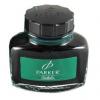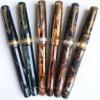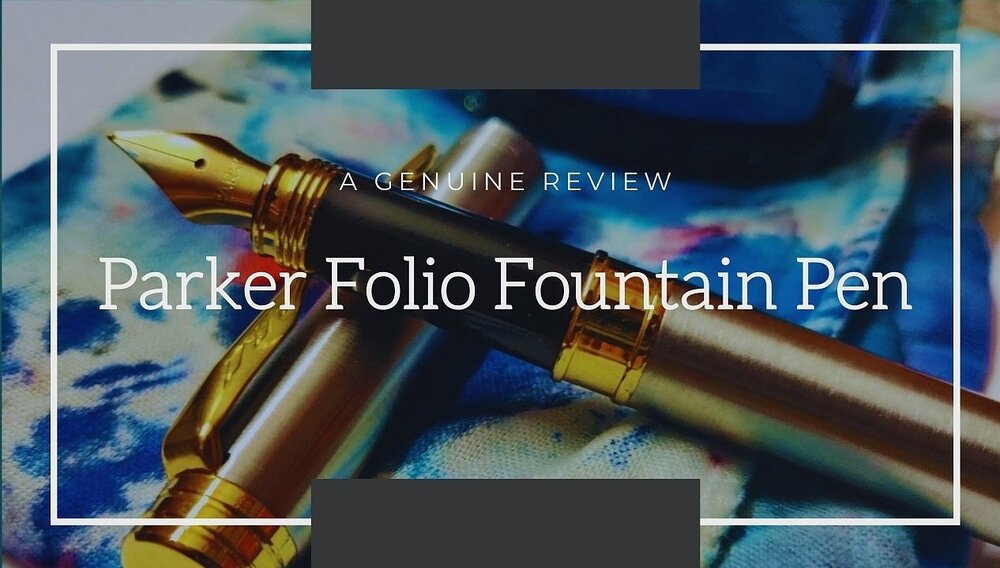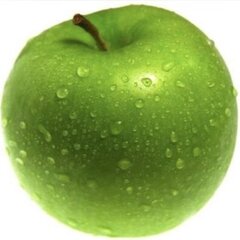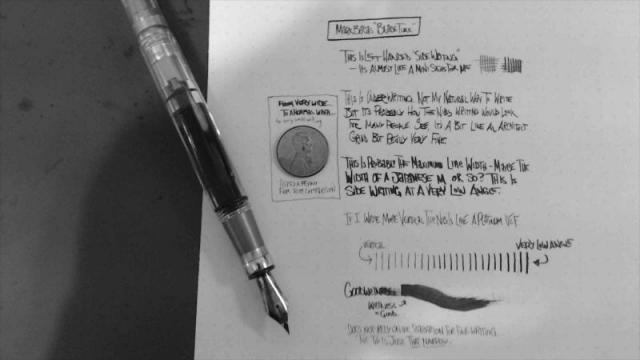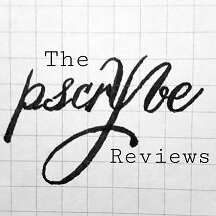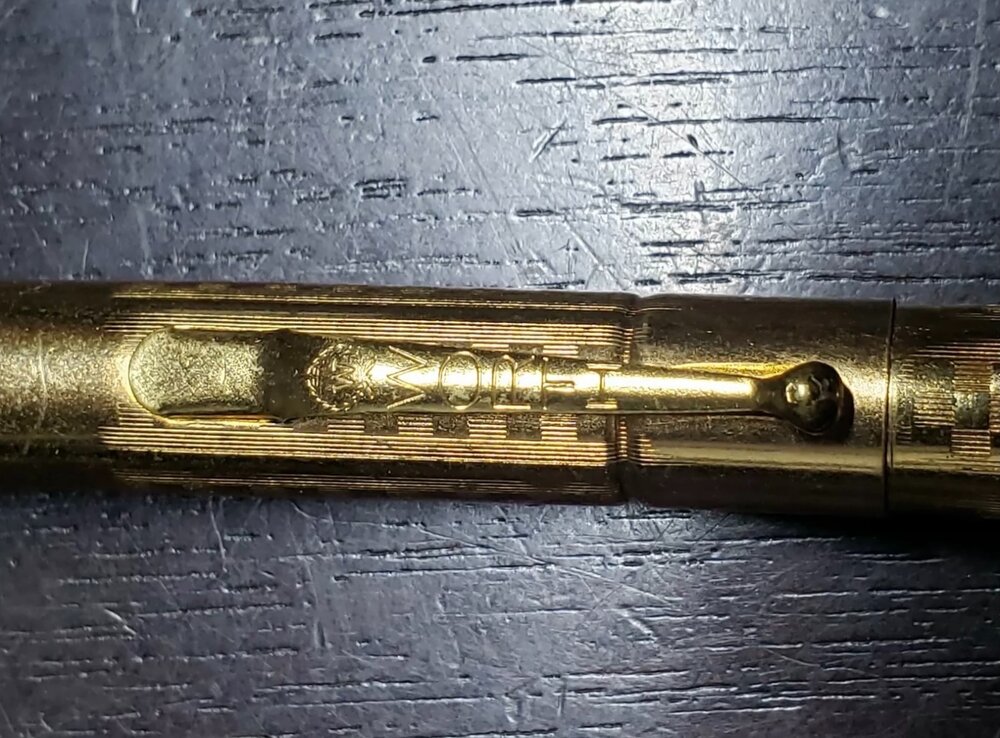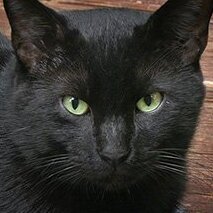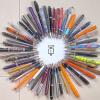Search the Community
Showing results for tags 'fountain pen'.
-
Hi, I am justin and I am from a small town called leesburg Texas, I have formed a pen club for individuals from around the area. Called the East Texas Pen Club if anyone is interested, we would love to have several new members. We meet on the first Saturday of every month in Longview, although this one is being rescheduled due to the severe weather we had. You can message me or you can find us on Facebook if you would like some more information. As I said we are new and have only had one meeting so far. https://www.facebook.com/groups/1073648183520263/?ref=share_group_link
-
- texas
- east texas
-
(and 5 more)
Tagged with:
-
This is my first Santini fountain pen and it's the one I like more till now. I'm a fountain pen lover and my favourite ones are my ebonites. They are all hand crafted by artisans. The one I introduce you now is the Santini Libra Voyager with the superflexy nib. It's a bit special because it's made with care and love by Italian craftsmen who know well their work. These are my first impressions more than a review. Appearance & Design (10) In my view, it's appearance is beautiful. The swirls among blue, turquoise, green, magenta and black in the ebonite are always very nice to watch, it's mesmerising if you turn the pen. The material is precious (rubber with sulfur, badly named as hard rubber); it's name comes from it's similarly with ebony. The design is very well thought-out. It is uncapped in one and a quarter turn. The clip is long but is very tight (too much). The section is long and very comfortable to hold and it tappers up at the end a bit preventing your fingers to meet the nib. It's gurthy enough for my liking. The Santini 18 kt gold nib (superflexy in this piece) has one advantage: you can interchange with other Santini nibs. It can be posted very securely but I do not recommend you to do it because with time you can damage the surface of the ebonite (if you like posting, do it with care). The pen is exquisitely beautiful and the workmanship is top notch. The ebonite warms to my hand and the pen is a comfortable writer. Construction & Quality (9) Outstanding construction and quality. The pen is beautifully made. Ebonite is a precious material for me. The fountain pen is handcrafted (I give a high value to pens made with experienced hands more than inyected plastic, for example). This pen is made by artisans and well engineered. The quality of the threading is outstanding. It has very comfortable long section. Perfect and beautiful cap band. The clip is very tight, it's a pity. It's the only bad detail and that's the reason to have a 9 instead of a 10. The polishing is very good and the pen is full of well made details. I remember that Da Vinci said "details make perfection and perfection is not any detail". Weight & Dimensions(10) Weight: 31g Length: 145mm. 135mm uncapped Cap length: 68mm Cap diameter: 17mm Body diameter: 15mm (max) It has a perfect balance. It is a not very lightweight nor heavy and comfortable pen. It's a gurthy pen but not too much, I feel that dimensions like the perfect ones. The grip is 11.4mm at its narrowest and is very comfortable between your fingers. It's slightly hour-glass shaped and flares out closest to the nib so your fingers won't slip. Nib & Performance (10) The nib is a Santini 18kt gold extra fine and flexy (they call it superflexy but it's really a nice and very good semi flex), so it's performance is assured. It does not require a lot of pressure to flex but it doesn't open like a wet noodle. It writes beautifully and with very good and nice line variation if you want and very good snap back. You can choose among plenty of different nibs with different sizes (it's one of the best companies if not the best in the world about offering diferent nib options) and plating. Mine has a bit of feedback (I prefer that characteristic better tgan the glassy nibs) and it's juicy, without being a gusher. The nib comes with an ebonite feeder to keep a well flow. Santini makes their nibs and I really appreciate that. I think in Italy only Aurora and Santini make their own nibs. Filling System (10) I like piston filling systems. The pen encapsulates a Schmidt piston component with a ratcheting sound that alerts you when you've filled the pen completely. It has a ink capacity around 1.1~1.2 ml. Schmidt is a well-known German quality brand and their piston component is reliable and as sturdy as a classic piston filling system. If you have any problem, Santini has a repair service that if it is like their fabulous customer support and service, I wouldn't think about that. I know you have to store the pen with care and without light and to dry it well after washing but I prefer the feeling of ebonite when you touch it and it looks beautiful. Cost & Value (10) The quality/price ratio is very good. 369 € including shipping is a fair price. But the good point is it's value, it's a fountain pen made by hand, if you take only that into account, it's real value is very high. Beside that it's made with care and love and perfectly engineered. Katrina (customer service) is so kind and professional. The way she supports and deals with you is outstanding and they send you the pen very fast. Conclusion (Score, 59/60) I feel very happy with this fountain pen. It is beautiful and very well made, with love by artisans. Very well engineered and thought-out. I am also very satisfied with their customer kindness. I think we do well to support handcrafted fountain pens. I am perhaps a bit viassed because I do love ebonite. The price is more than right if you consider the artisan work. They are all craftsmen. They also package the fountain pen beautifully. Santini does not appear to invest in marketing and I think they sell most of their products directly to the end customer. I think that their pens are of perhaps superior material and quality than the better known Italian brands. This pen will remain one of my best. I have become a fan of Santini. I would like to give my congrats to all Santini team, they are great. Best regards to everybody. Take care Miguel Ángel.
- 10 replies
-
-
desaturated.thumb.gif.5cb70ef1e977aa313d11eea3616aba7d.gif)
Platinum President fountain pen in blue PTB-20000P#59 still officially listed
A Smug Dill posted a gallery image in FPN Image Albums
From the album: Translated third-party content
In reply to: https://www.fountainpennetwork.com/forum/topic/368207-platinum-president-in-bluewhen-was-it-made/© Platinum Pen Co.
- 0 B
- x
-
- platinum president
- blue
-
(and 2 more)
Tagged with:
-
This isn't my first Ranga fountain pen but it's the one I like more till now. I'm a fountain pen lover and my favourite ones are my ebonites. They are all hand crafted by artisans. The one I introduce you now is the new Ranga Markandeya. It's a bit special because it's not the typical "jumbo" sized pen (I like big pens but also medium sized ones), although it's gurthy externally (not too much). It's special because it's made with care and love by Indian craftsmen who know well their work. Appearance & Design (10) In my view, it's appearance is beautiful. The swirls between teal blu and orange brown in the ebonite are always very nice to watch, it's mesmerising if you turn the pen. The material is precious (rubber with sulfur, badly named as hard rubber); it's name comes from it's similarly with ebony. The design is very well thought-out. It is uncapped in one and a quarter turn. The clip is long and springy. The section is long and old fashioned in the best way because it's very comfortable to hold and it tappers up at the end preventing your fingers to meet the nib. I like the cap meets the body with the same width and it's gurthy enough for my liking. The Jowo nib (B in this piece) has one advantage: you can interchange with other Jowo nibs I'm sure you have and, if you haven't any, it's very easy and cheap to find one. It can be posted very securely but I do not recommend you to do it because with time you can damage the surface of the ebonite (if you like posting, do it with care). Construction & Quality (9) Ebonite is a precious material for me. The fountain pen is handcrafted (I give a high value to pens made with experienced hands more than inyected plastic, for example). This pen is made by artisans and well engineered. The quality of the threading is outstanding. It has long section threading to be well eyedroppered if you prefer that system with huge ink capacity. Why I don't give a "10"? Because of the micro scratches from the lathe (almost imperceptible but they could be completely eliminated). The polishing is good but not perfect. I remember that Da Vinci said "details make perfection and perfection is not any detail". Weight & Dimensions(10) It's weight is 24 grams capped and 15 uncapped, with perfect balance. It is a lightweight and comfortable pen. It measures 134 mm capped but the good point consists of it's long enough uncapped, 122 mm, very good, well done. The nib goes close to the end of the cap. I appreciate that because you can have a long enough uncapped fountain pen without sacrificing the total length in order to get relative restrained length. It's a gurthy pen but not too much, 16 mm in the middle. It tappers down in the cap to 13,5 mm and to 12 mm in the body. I feel that dimensions like the perfect ones. Nib & Performance (9) The nib is a standard broad Jowo stainless steel one, so it's performance is assured. But you can choose a Ranga or Bock if you want, even gold or titanium with different sizes and plating. Mine is very smooth and juicy, without being a gusher. Filling System & Maintenance (9) The filling system is possible in three ways, cartridge, converter and it also can be used with eyedropper. It comes with a standard Schmidt converter. The maintenance is very simple to realise due to the converter system. I like piston filling systems and eyedropper and vacuum systems with shut off valve to avoid burping but using that kind of systems you increase the price and the maintenance is not so easy. I know you have to store the pen with care and without light and to dry it well after washing but I prefer the feeling of ebonite when you touch it and it looks beautiful. Cost & Value (10) The quality/price ratio is outstanding. In my pen 79 $ including postage (64 without it). But the good point is it's value, it's a fountain pen made by hand, if you take only that into account only, it's real value is very high. Beside that it's made with care and love and perfectly engineered. I got the pen in a group buy directly with mr. Kandan M. P. He is so kind and professional and they send you the pen very fast although I don't mind to wait if they use Indian post because it's cheaper. He has told me they are going to use this way to offer free shipping. Conclusion (Final score, 57/60) I feel very happy with this fountain pen. It is beautiful and very well made, with love by artisans. Very well engineered and thought-out. I am also very satisfied with their customer kindness. I think we do well to support handcrafted fountain pens. I am perhaps a bit viassed because I do love ebonite. The price is more than right if you consider the artisan work. They are all craftsmen. They even give you one free fountain pen. It is a modest but functional one and I really appreciate that gift because it's a nice detail and remember Da Vinci... Best regards to everybody. Take care Miguel Ángel.
-
Picked this PILOT fountain pen with PILOT 9007 converter from a flea market. Could not able to find the model of it. Any information would be appreciated.
- 1 reply
-
- pilot
- pilot 9007
-
(and 1 more)
Tagged with:
-
With the recent Stipula Etruria thread that was posted in this sub, I thought it was high time we had a dedicated photo thread for the Montegrappa Extra. This can include the earlier Classica and Historia models, along with the more modern variants including the Extra, Extra 1930 and Extra Otto. The key here is to share what you have no matter the size of your collections or your photography skills, so that we may appreciate, discuss and enjoy the variety of trims, nibs and colours these exquisite pens are available in. My hope is that this will breathe a little more passion into this model and to see our own interpretations of how we use them in the 'real world'. This will also provide a valuable resource for those looking to research the model and perhaps make their own decision to one day acquire an Extra or two. Let me kick us off with two of my favourite Extra's in my collection; an Extra Otto in Lapis Blue with a Fine nib, and an Extra is midnight blue celluloid with the older style barrel imprint and a Medium nib. I am soon to add another one when it arrives from Italy, will post a group shot then. I hope that others will follow with their shots
- 246 replies
-
- montegrappa
- extra
- (and 4 more)
-

Waterford Powerscourt Fountain Pen early review
donnweinberg posted a topic in Other Brands - Europe
I recently purchased on Ebay for USD$150 a gold-plated Waterford Powerscourt fountain pen with a fine 18K/750 nib and have used it for a week, writing with it at least twice each day. Here are photos, to be followed by my impressions at this relatively early stage. The pen is very attractive and feels nice in the hand. It has a solid feel and nice weight; the pen is of average length and weighs 41 grams. It fills easily with its included converter. I used Noodlers Green ink. It took awhile for the pen to write consistently; at first, it skipped a bit. The fine nib writes with a relatively dry line. The nib is on the firm side and makes an easily audible sound when writing on decent quality paper. My "gut" feeling is that the Powerscourt is an attractive pen that feels nice in the hand but writes in an uninspiring manner. I gather that for my tastes, a medium or broad nib (which I generally prefer) would feel better. However, my guess is that the Waterford line is more about looks than about the writing experience. What are the experiences and impressions of others who have written with this pen or other Waterford pens? Am I being unfair to this pen and brand?- 1 reply
-
- waterford
- powerscourt
-
(and 2 more)
Tagged with:
-

The Fountain Pen Revolution Tanoshii (incl Urushi Art and Junior versions)
Jamerelbe posted a topic in Fountain Pen Reviews
Fountain Pen Revolution Tanoshii – Welcome to (or from) Japan?? In August 2020, the folks at Fountain Pen Revolution began “teasing” a new pen design that they were getting ready to release. The FPR Tanoshii, and the Tanoshii Junior were (as far as I can recall) the first pens in their range to be designed and made outside of India. Kevin’s partners are based in Japan – though an online search pens themselves might be made in Taiwan? I liked the look of these pens, but not quite enough to be ready to shell out for one. That perspective changed, though, when FPR started selling a “Urushi Art” version (or rather, versions) of the larger pen, with attractive and vivid designs on the barrel of the pen. A, *ahem*, fairly significant birthday was coming up, so I placed an order… Kevin kindly included a Junior version as well, so I could compare and contrast (and, if I wished, publish a review!) – I mention that up-front because, as hard as I try to be impartial in my reviews, I prefer to be up-front about anything that could (unwittingly) skew influence my perspective. The Tanoshii line of pens are the most expensive in Kevin’s range – but the moment you get them in hand you’ll see why. They’re clearly manufactured to a high standard. I’m not going to ‘score’ the pen for the different categories listed below – but will try to give a clear indication of where they land. One last thing to mention up-front: this review will focus primarily on the Urushi Art version of the full-sized pen – but will make frequent comparisons to the Tanoshii Junior. ______________________________________________________________________ Appearance & Design For the most part, the FPR Tanoshii and Tanoshii Junior counterpart conform to a fairly standard (and elegant) pen design. The cap screws snugly over the grip section, with only a slight step-down between cap and barrel. The pen is at its girthiest around the cap-band, and tapers slightly the top of the cap and the bottom of the barrel. The full-sized Tanoshii sports gold-plated trim (clip, bands and nib), while the Junior has chrome-coloured trim – I’d like to see both options available for both sizes of pen, but don’t know whether that’s in the works. The clip is one of the more distinctive features of the Tanoshii pens – it swoops down from near the top of the pen to terminate on a ball-shaped attachment, which can be made to roll as it glides over the fabric of a pocket or pen case. I find the clip holds the pen quite firmly in place in my pocket – which is doubly important when you’re carrying a piece of art around! The other distinctive feature is the ornamental pattern inscribed onto the cap band – I wasn’t really attracted to this at first, especially on the chrome band of the Tanoshii Junior (I’m not normally a fan of ‘flashy’ pens). I have to say though it’s grown on me over time. Size Comparison (top to bottom): TWSBI Diamond Mini, FPR Tanoshii Junior, FPR Tanoshii full-size (urushi), Lamy Safari, TWSBI Diamond 580 AL I really like the materials Kevin chose for the manufacture of these pens: The cracked-ice style acrylics are brightly coloured with moderate translucency (you can select from blue and orange barrels paired with solid black grip section, cap and finial; or a ruby barrel paired with white grip section, cap and finial). If you prefer a more understated option, you can purchase an all-black version – which I believe forms the base for the Urushi Art versions of the pen. FPR Tanoshii Junior - Ruby/White version Here, obviously, is where things really got interesting for me. The Urushi Art versions of the pen are brightly coloured, and absolutely gorgeous. The artwork on the two ‘plainer’ versions of the pen (Green Genji and Golden Cloud) are made up purely, as far as I can tell, of layers of urushi lacquer and gold metallic powders; while the other four pens boast an elaborate artwork / decal (Red Phoenix, Blue Dragon, Red Dragon, and Black Dragon). I was keen to buy one of the plainer pens, but Kevin urged me to go for one of the more decorative pens… so I opted for the Red Phoenix. [I’m still really tempted by the Green Genji, but… my wallet keeps telling me no!] FPR Tanoshii Urushi Art - Red Phoenix According to FPR’s website, “Each FPR Tanoshii Urushi Art pen is its own masterpiece. They feature the original Tanoshii design and filling system but turned into a work of art by skilled craftsmen using Japanese Urushi art.” Rather than try to describe the urushi technique, I’ll also include here a word from the manufacturer, as Kevin from FPR passed it on to me: “Urushi arts in the pens are done by applying different colors of Urushi, gold and silver metallic powders, decorative ultra-thin golden/ colorful paper for different themes. Then applied transparent layers of Urushi called “Ki-narinuri” over and over and one by one. After each layers of Urushi, Urushi needs to be dried and polished for smooth feelings.” If I’m reading that correctly, it means the Red Phoenix on my pen is some kind of paper artwork that’s been carefully adhered around the surface of the pen, and lovingly lacquered into place. Not as impressive a feat as an individually painted design, to be sure – but it’s amazing to look at nonetheless, and for someone (like me) who can’t justify spending hundreds or thousands of dollars on a pen… this is a great alternative. It also creates a kind of ‘three-dimensional’ appearance, with the design sitting slightly proud of the pen barrel – you can also ‘feel’ the design elements under the lacquer of the pen. … Construction & Quality As I mentioned in my introduction, this is the highest production quality pen that FPR have produced to date – and (almost) everything about it screams ‘quality’. The acrylic pen parts are expertly machined; the cap threads are smooth, and produce an excellent airtight seal; inner threads of the grip section are made of metal (stainless steel), and thread smoothly and firmly into the barrel. I was gifted a Pilot Custom Heritage 91 last year (thanks to a YouTube giveaway by Alesa of the Inky Rocks channel!) – and I’d say the production quality of the Tanoshii is pretty comparable, though minus the gold nib! The Urushi Art seems quite robust, and won’t easily wear off the pen – but obviously will benefit from gentle handling. This isn’t a pen I carry with me everywhere – though of course you can if you want to! … Weight & Dimensions The FPR Tanoshii and Tanoshii Junior are both very light – 21.7g vs 17.6g respectively – with roughly 1/3 of the weight residing in the cap. The full-sized Tanoshii is 135mm long capped, and 124mm uncapped – you can post the pen if you wish, but it’s not recommended for the Urushi Art version (in case it mars the pen). The Junior version is 11.4cm capped, and 9.7cm uncapped – which in my hands is just a little too short for comfortable extended use. Posted, it extends to 12.9cm, which works much better for me. I do wish it posted just a *little* bit more securely onto the back of the barrel, but that’s only a very minor nitpick on my part. The diameter of the pen at its widest (cap band) is 14mm – this tapers to 10mm towards the bottom of the barrel, while the grip section tapers from 11cm (near the threads) down to 10mm (near the nib). That’s pretty much in the ‘sweet-spot’ for me. … Nib & Performance When the Tanoshii was first released, it was only available with JoWo nibs in F and M – it’s designed to take standard #6 JoWo screw-in units, so you can easily swap in replacements if you wish. The advantage (for me) of waiting a while to purchase is that Kevin managed to source some nib units that are compatible with the JoWo threading, but can accommodate FPR nibs – so I ordered mine with a two-tone FPR Ultraflex nib (for an extra US$21). The Junior pen takes a screw-in nib unit with FPR’s standard #5.5 nib – Kevin kindly included an ultraflex nib in this pen too. The nib units in both pens come with plastic feeds – but they seem to keep up well with the flow. FPR #6 Ultraflex nib (two-tone) FPR #5.5 Ultraflex nib (chrome) I’m a real fan of FPR’s ultraflex nibs – though they can be an acquired taste for some! – and I’ve loved writing with these ones. The larger #6 nib can flex a little further than the #5.5 with less downward pressure on the tines and in my experience is a little wetter. Both pens are prone to railroad if you try to flex too far – but don’t require a lot of coaxing to get them back up and running again. If you’re not keen on flex nibs, you can order a range of other options in both pens – EF, F and M options are included in the price of the pen; B, stub and standard flex nibs cost a little extra (US$4 at the time of writing); while the ultraflex adds a further US$14 to the cost. I have yet to try the gold flex nibs – the USA to AUS exchange rate puts that a bit out of my budget for the time being! In my opinion FPR’s steel nibs are great value for money – though I’ve sometimes found the stub nibs needed some ‘tweaking’ in the past. Aesthetically, the larger nib goes will with the bigger pen, and likewise the smaller nib with the smaller pen – I probably prefer the writing experience with the full-sized pen, but they’re both very pleasant writers. … Filling System & Maintenance The full-sized Tanoshii pen comes with a screw-type standard international converter, though it can also take standard international cartridges. The Tanoshii Junior comes supplied with a Kaweco-style (push-pull) mini-converter, which doesn’t hold a whole lot of ink – that’s probably the only real down-side to the smaller pen! I wouldn’t recommend eyedropper filling these pens, as I don’t know how long the metal threads would last without starting to corrode. The pens can be completely disassembled and reassembled for cleaning. The nib units are friction fit, so can be pulled apart to swap in replacement nibs – I don’t believe FPR sell replacement nib units for the smaller pen, though as mentioned above, the larger pen will accommodate any standard #6 JoWo nib unit. … Cost & Value At US$70 (plus postage) for the ‘regular’ pen or $65 for the Junior, the Tanoshii is not cheap – but it’s definitely in the ballpark for an American/Japanese collaboration pen, especially given the high quality workmanship. I can’t praise highly enough the artwork on the Urushi Art version – it nearly doubles the cost of the pen, but given the amount of work involved in their production, I’d say that’s money well spent. I’m a repeat customer at FPR, and have to say that, much as I love my Himalayas and Jaipurs (especially the V2s), this is the best pen I’ve bought from them thus far. … Conclusion The Tanoshii, Tanoshii Junior and Tanoshii Urushi Art are great pens to look at, great pens to write with, and in my opinion are great value for money. Happy to answer any and all questions below – but thoroughly recommend these pens to anyone who’s interested. … -
Hi I got this pen at a car boot sale and want to know what it is but honestly have no idea and says nothing on it except made in France and iridium point that doesn't help much
-

Conklin Duragraph Screw In Nib Unit, Replacement Options?
rogerbikeswim posted a topic in Of Nibs & Tines
Conklin Duragraph Fountain Pen, Amber - 1.1 MM Steel Stub Nib Hello, I recently purchased this pen recently for $32 on Amazon. I'd love to know what my options are for swapping between the screw-out nib units for this pen. I obviously know that I can get the Conklin replacements. I'm wondering if it uses a standard size that can be swapped out for those of different manufacturers. I tried my Franklin Christoph nib - no joy there. It the FC unit just spun in place. Also, I looked for this information before hitting you guys up. I'm also interested in how to find this out for myself next time. Where can I find what nib units are swappable. Thanks.- 22 replies
-
- conklin duragraph
- conklin
-
(and 3 more)
Tagged with:
-
CALICUT CITY- SOME UNTOLD STORIES I don’t how many could believe that Calicut, a city of Kerala, have such a rich heritage in fountain pens- so that it may be called as the pen city of Kerala. Probably as the only man in FPN from Calicut, I take the responsibility to present our city in this forum. The pen productions have started in early 1950s. By 1955-1960, there are four major firms of pen making. Don’t think that these are big companies producing pens and marketing in wide areas. Actually these are four pen shops, and each shop produced pens for their own shops only. And because of this poor marketing strategy, they are almost unknown to the outside world. As the healthy competition continued, many beauties have born. The pen history can be roughly be divided into 6 phases. 1950 - 1955 PEN PRODUCTION begins . 1955 - 1960 CONSOLIDATION PHASE – By this period all the 4 pen shops came into existence and production started at full swing. 1960 - 1970 THE GOLDEN ERA. This period have witnessed these shops running in full glory, churning out the maximum number and variety of pens. 1970 - 1980 THE DECLINE STARTS 1980 - 1990 THE BIG DECLINE 1990 - PRESENT. All the things happened right here- in the SM Street. The most busy street of Calicut. SM stands for Sweet Meat. Wondering what’s sweet meat ? . It’s nothing like meat. A hard rubbery confectionary -or Calicut Halwa- as known outside Calicut. You can see a lot of shops selling this here. They are available in a variety of colours and flavors—atleast twenty I think- more that what colours you are getting for a Sheaffer Skrip or Waterman range of inks! ABOUT CALICUT For those who don’t know, Calicut ( or KOZHIKODE) is a city situated in the coastal Malabar area of Kerala, India. It’s the only place in Kerala where fountain pens are made. Calicut is also known as the Biriyani capital of Kerala. Wonder why .. all pen cities are famous for their biriyanis also ..!? the Malabari biriyani is made in process were all the rice, meat and the spices are cooked in a closed container where the soft aromas and infused to rice in a slow process of around 5-6 hrs. Now, coming to the story part - The whole credit of fountain pens of Calicut goes to one and only person- Mr. M. Haneefa Rawthar- for without him the story would not have happened. People called him Haneefa Saheeb. He came from somewhere in Tamil Nadu in around or before 1950. At that time ( and now also) many people comes from other states to Calicut as merchants. His first visit was somewhere around 1950. He came with a huge collection of fountain pens- used and new, along with a lot of spare parts. Usually persons coming to Calicut are attracted by the hospitality and friendliness of natives and most of the merchants and traders later decided to settle here. Haneefa Saheeb was no different. Don’t think that there was no pens at all before Haneefa Saheeb. Imported pens like Waterman, Black bird, Swan were there. These were costly and not afforded by all. Apart from regular pens, dip pens were also popular. Ink tablets were also popular at that time. For making ink, you have to dissolve tablet in water! For dip pens, thicker inks were made with tablets dissolved in lesser water. Also they were available at very cheap rate compared to an ink bottle. Any ink manufacturer reading this? Coming back to Haneefa Sahib, a man with no formal education, but lot of experience from worldwide travelling and visiting so many countries, now at his fifties or sixties, toying with the idea of starting a pen shop at Calicut. FIRST PEN SHOP OF CALICUT The first pen shop of Calicut opens in SM street in 1950. As expected the shop flourished very quickly. This shop later became Kim and Co pens, as known today. As he sold new and old pens, he provided them with good service, as he had a huge collection of spares. Kim and Co shop at Calicut.( at present)
- 69 replies
-
- fountain pen
- kim
-
(and 3 more)
Tagged with:
-
Recently I was going through the youtube there I saw a fountain pen never heard off....the name is Parker Folio Fountain Pen. Any update regarding this pen?
- 7 replies
-
- indianfountainpen
- parker folio
- (and 7 more)
-
I just aquired an old pen. Changed the sac and filled it up. A nice ex fine flex nib. The pen has the inscription "registered Fascio pen" and "R14K Fascio". I tried to find some information about it on the net, but in vain. Anyone here who knows anythong about this pen?
-
The PenGraver Man When I was a kid, a few people engraved on Fountain pen. They were available at the train station and often traveled in compartments from one station to another. They carried a small briefcase in which they stored engraving tools. If someone among the passengers had a fountain pen, they asked for engraving the owners' name. The engraving charge was a few cents only for English and Bengali languages. I forgot the local name of their profession. The engravers also went to our schools wearing white pants and a shirt, the small briefcase in hand. Most of them had great skill in cursive handwriting font. I can only remember the small chisel, hammer, and the thuk-thuk-thuk sounds! The last time I saw them was in 1994 at Ishardi Railway Station in Bangladesh. I have lost the few pens I had engraved my name, but a few years back, I have found a White Feather fountain pen in a salvage yard with a name curving on it. I'll post the photo later. Can anyone tell me if the pen engraver had a particular word for their professions' name? Please let me know. Thank you all in advance. Leo amahadleo@gmail.com https://www.facebook.com/groups/fountainpenculture
- 5 replies
-
- fountain pen
- pengraving
-
(and 1 more)
Tagged with:
-
I might be retiring from teaching at the end of this year, and I am thinking that I might get myself an all-wood pen (section is wooden, also) to celebrate. I might even do a special order. I won't be able to spend more than 500USD. Any recommendations for a maker or brand? I really know nothing about this kind of thing, but I am very intrigued. I've already looked at Ryan Krusac's website.... Thanks.
-
I would like to introduce you my last Leonardo fountain pen: The Leonardo Momento Zero Grande Golden Rule. This a collaboration with J.Brooks, who made this beatiful resin, where bronze and red are mixed to create a fusion of warm colors. Limited edition to only 70 pieces worldwide. The first time I saw this pen I fall in love due to the red parts among the bronze style resin. After seeing the feed, made out of red ebonite... that was the end of my piggy bank. I got it at "Fontana Penna" in Spain. Now that it has arrived to me, I have been deeply impressed by it and I could not be more happier. That cap, with so much red on it, makes this pen unique to my eyes. I have to admit it was definitely a great purchase. Thanks to Leonardo & Carolina pen company for making this beautiful fountain pen.
- 11 replies
-
- leonardo
- momento zero
-
(and 2 more)
Tagged with:
-
-2160-2-Square.thumb.jpeg.4a5ced0d9f0ddd09129bee4ae1d4e8ee.jpeg)
White Lightning Ink Additive: anyone know of a UK retailer?
Joe Lafferty posted a topic in Of Nibs & Tines
HI, I'm new to the network having a revived interest in fountain pens over lockdown, resurrecting some old pens and adding a few (too many!) new ones... lots of fun!! I have some pretty dry inks and some F and EF nibs, and after research I'm wondering if getting some White Lightning Ink Additive might help the pens write a bit wetter. However, I cant seem to find a UK retailer that stocks the product and paying almost $40 for shipping seems a bit OTT... Does anyone know of a retailer that stocks it in the UK or Europe? Thanks, Joe- 3 replies
-
- fountain pen
- ink
-
(and 4 more)
Tagged with:
-
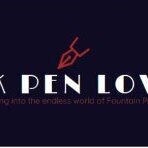
OPUS88- Lennon Toolbar Collaboration Halo Pen Review – It’s Absolute Stellar!
punjabi posted a topic in Fountain Pen Reviews
Pros- Huge Ink Capacity Shut-Off-Valve prevent leaks & burps. Unique Ice-Effect Design Well Balanced Good Quality Material used – Scratch Resistant The Jowo nib on my Opus 88 writes flawlessly. Nice Packaging Comfortable even when used capped Fits perfectly even in people with small hands. Affordable Price Tag Good EDC Pen Cons- It takes many turns to uncap – 3 turns!!!! You need to open valve for long writing sessions Some Other Specs You Should Know – Nib Material – Steel Body Material – Resin Fill Mechanism- Eye Dropper Ink capacity -2ml Cap Type- Threaded Postable-Yes Demonstrator- Yes Clip Style- Spring Metal Nib width- Extra Fine, Fine, Medium, Broad & Stub. Closing System- Screw cap Material- Resin Trim Colour – Silver Length Closed – 142 mm Length Barrel – 125mm Length posted-160mm Diameter- 14mm Diameter – Grip10.7 mm Weight-Barrel (Empty)- 0.46 oz / 13 grams Weight(Cap)-0.39 oz / 11 grams Weight – Whole Pen (Empty)-0.84 oz / 24 grams Packaging – Very Nice 👍, this pen comes in a light blue box over which both OPUS88 & Lennon Tool Bar Branding. It looks very very nice with a beautiful white box inside where pen sits comfortably. Their is a very nice eye dropper adjacent to pen. You never get this kind of premium packing at this price point. You will surely like the unboxing experience. Design- Very Nice, The body of the pen is made of very nice resin,it feels good in hand & material is almost scratch proof. The Lennon Tool Bar logo has been engraved on top of The cap. It has OPUS88 written too on back of clip. It looks nice IMO. The overall shape is a hybrid of both the classic flat-top classic cigar shape designs. The pen gradually gets wider as you move towards the middle of the pen and reaches its widest part on the cap.The clip is very sturdy & is reliable. The pen comes with #5 size nib,but I think size #6 nib would have been better. The finials have a mostly flat end, but there is a slight rounding to them which in my opinion looks very good. Their is an O ring at the bottom, which suits the overall appearance of the pen. Their is slight step down on section. The pen takes too many turns to uncap, around 3 which some people won’t like. Filling Mechanism- Good 👍,OPUS 88 has been making great Eyedroppers since many years now, this pen is too a no nonsense eye dropper with a shut off valve.As, you don’t need to apply silicon grease on threads unlike other ED Pens which is a very nice thing .It a simple mechanism & works perfectly. The ink capacity is around 2ml which is on higher side. The shut off valve has some impact on ink flow, but not much.I am personally fan of shut off valve filling mechanism rather than normal Eye dropper. Nib Performance – Good 👍, This pen comes with #5 steel nib. It is made by JOWO but tuned by OPUS88. It is smooth & writes very well out of the box & has very less feedback. The nib has brand name & nib size printed on it . The pen wrote very well out of the box. Overall- Very Nice 👍, This is made by OPUS88 in collaboration with Lennon Toolbar Inks, Both are young companies but they have done really great job with this pen, improving the earlier shortcomings. The pen is very nicely built & a quality product. It’s MRP will be around $90 in USA which makes it strong competitor to other pens available in this price segment. If someone is looking for a clean eye dropper pen around $100 range it’s the best. PS- I purchased this pen from Taiwan through a friend who pre-booked & then shipped to me here. And images shared have been taken by HC LEE, My images couldn’t have done justice with beauty of the pen. My blog link - https://inkpenlover.wordpress.com/2021/06/07/opus88-lennon-toolbar-collaboration-halo-pen-review-and-its-absolute-stellar/?preview=true- 10 replies
-
- opus 88
- fountain pen
-
(and 1 more)
Tagged with:
-
Hey guys! Normally post in the Japan pens forum but I picked up a TWSBI 580ALR from Mark Bacas with a special nib grind and I wanted to share some info about it. First off - the ALR is just like an AL except the cap band has a difference finish(?) and most importantly the grip section is 'ribbed.' The lines on the grip section feel amazing, really good to the touch. I consider it an upgrade from my AL, but you do have to be careful not to get ink in those lines because you would have to clean it out. Mark Bacas is a popular nibmeister. You can see his work at https://www.instagram.com/nibgrinder/ I got the 580ALR with a Blade Turk grind and if I had it to do over again I would send him my nicest pen because it's an amazing grind. The Blade Turk is a mini-architect grind with a gentle curve so you get a controlled gradation of line width from Platinum UEF to Japanese M. It's a really versatile tool. Anyone could just pick it up and write with it, but if you vary the angle up or down you can variation in width. An artist could probably build a whole career around this nib, as the more you use it the more you get to know what it can do and get the line widths you want without even thinking about it. Here's a video demo I made of the pen & nib: And here's an additional photoset: https://imgur.com/fpngallery/eXPLoO9 Mark Bacas deals TWSBI pens so I think you can just order a nib from him already ground to load into your TWSBI. This gives some additional options for nib types normally only found on Japanese pens, for example... or various architect grinds. Anyhow, I really love the pen and I'm considering sending him my King of Pen to work on next. This Blade Turk is just such an interesting and unique grind. I'd recommend it for any artist but also anyone who just wants an interesting fountain pen nib that is still appropriate for every day use.
- 14 replies
-
- twsbi
- fountain pen
-
(and 4 more)
Tagged with:
-
Hi everyone. First review here and open to suggestions. This is largely pulled from my blog post on the Lorelei with minor edits for your reading pleasure! Appearance The Lorelei appears to be a dupe of the Sailor Procolor 500. Mine is a clear demonstrator with silver trim and the clear feed displays inks quite nicely. The brand name”LingMo” is engraved on the trim of the cap in a similar manner found on the Sailor Procolor. Even the font used is similar to Sailors and the similarities don’t end there. LingMo Lorelei Converter. Potential Sailor CON dupe.Filling System The pen came with a piston converter which, knowing Chinese brands, could be a duplicate of the Sailor converter though I do not have a Sailor pen to try it out with. The converter looks similar to the Sailor converter but has a small metal object inside to break surface tension of the ink and works fine, fitting securely into the section. So well in fact, that for a moment I thought it was not removable when I first tried to remove it ! I noticed that the section came with an O-ring which gave me hope that it could be converted into an eyedropper to further show off the ink inside and it’s demonstrator body. Those hopes were dashed, however, as the barrel isn’t a single piece of plastic but two pieces. A tiny little plug at the end of the barrel closes it off and will leak. I was devastated. Functionality The clip on the cap is sturdy but quite hard and probably will not clip onto thick fabrics without doing damage. The cap is a threaded cap which screws on securely, though I’d be careful about over-tightening and cracking it. The cap posts by friction, no rattling or anything, and the pen is light & comfortable to write with posted or unposted. The nib and feed are friction fit, making for easily disassembly and cleaning. Write-ability The F nib produces a 0.5 line. It is a hard nib that produces little line variation with quite a bit of force. Straight out of the box, the pen wrote well with normal ink flow. There were no hard starts or any fiddling necessary to get it writing. The line produced appears the same as a Platinum Preppy F though the nib on my Lorelei was somewhat scratchier than both the tester in the shop and my Platinum Preppy F, feeling more like my Preppy EF nib. The pen I have was also wetter than the one tested in the store which already had decent flow. Personally, I find the LingMo Lorelei aesthetically pleasing (more so than the Wing Sung 659), and it has worked very well for me with no leaks or ink flow issues. I found it disappointing that the fully plastic body cannot be made into an eyedropper, but this should not be a problem for those of us who prefer cartridges/converters. Overall, a nice and affordable beginner’s fountain pen with a classic look.
-
I came across a “Worth” gold plated pen. I thought maybe it was a Woolworth store pen. Has anyone else run into a Worth pen? thanks
-
Watched a wonderful story tonight on NHK World News about a Japanese gentleman who blends custom colored inks for his customer's fountain pens. Story starts at 08:31: https://www3.nhk.or.jp/nhkworld/en/news/programs/#1005
- 3 replies
-
- ink
- fountain pen
-
(and 1 more)
Tagged with:
-
The Caran d'Ache 849 Ballpoint was the only ballpen I ever considered buying since I got into the habit of spending large sums of money on writing instruments, almost 5 years now. Knowingly or Unknowingly I never got myself to buy the (ballpoint)pen.Around March of this year,the Fountain Pen iteration of the Ballpoint was teased, it was love at first tease and so began the constant badgering of various pen retailers regarding launch and availability,always ending in disappointment,until Pen Chalet listed it on their website(first?) (June 20th) and I wasted no time in ordering mine. In eye bleeding Fluorescent Orange of course! Thanks to some amazing service by Pen Chalet,the pen reaches me in 2 days and has yet to leave my pocket, almost a month now. Presentation:The pen comes in a minimalist box with the Caran d'Ache logo on top and the Hexagonal logo on the sides. The bottom has the serial number sticker. Inside is the pen and a Standard Ink Cartridge of Idyllic Blue. Construction:At first glance the color of the pen hits like a wreaking ball! And after some squinting you want to pick it up.The paint job almost looks like Laquer,with some lighter tones along the edges. I have seen this same paint effect on the Caran d'Ache pencils. The pen has 6 sides to it with smooth edges which show off a different shade of the paint.Considering its a full metal construction its surprisngly light,robust and fells solid in the hand. The top finial is shiny metal with the Hexagonal Logo in embossed texture. The clip is chrome plated steel in the identical shape as on the Ballpoint pen. It has good tension and strength. Below the clip is "894 Caran d'Ache" printed in black and "Swiss Made" near the finial. I like this stealthy way of branding products.The cap and barrel are of a constant diameter through out the length.The bottom finial is also shiny metal with a minuscule gap between the finial and the barrel which allows the cap to be posted in a concealed way. Uncapping/Capping the pen is very reassuring and snug. It caps with a click. The Nib is a Steel #5 without a breatherhole and the Hexagonal Logo. I went with a Medium. The section is Glossy Black plastic which I have not found to be slippery. The section unscrews and a Cartridge or a Converter can be fitted.There is a 2mm step up from the section to the barrel,which may or maynot be uncomfortable depending on your grip. No issues for mine tho. Size Comparisons: Above to Below: Caran d'Ache Ivanhoe, Caran d'Ache 849 Fountain Pen, Lamy Al-Star, Pilot Metropolitan. Size wise the pen is pretty average and well balanced in the hand. Writing:The Medium Nib writes true to size and wet enough consistently for long writing sessions. Its very smooth,smooth enough to make it one of my smoothest Steel Nibs list topped by a Faber Castell steel nib. Another surprise was the softness to the nib.Its in no way a flex nib but it does have some pleasent bounce to it which makes you enjoy the nib a bit more compared to a nail. My medium definaytyly goes to a broad grade.I did not experience any flow isses out of the box so Kudos to Caran d'Ache for that. The Little things:The Color is very striking.Think traffic cone or High Visibility Jacket Orange! This pen WILL get noticed.The paint job is impeccable. Surprisingly soft nib.The pen has been clipped to Shirt Pockets and Jeans Pockets without any incident of accidental uncapping.The pen has been carried around daily for almost a Month and has suffered no cosmetic changes.Posting the pen makes it too long but does not make it back heavy.Plastic threads on section vs Metal Threads on the Section might breakdown over time.If you use a cartridge,a spare can be carried in the barrel.This color is very difficult to photograph! Conclusions:Pen Chalet has the pen listed at $52 which might be considered on the higher side for an "Entry Level" Pen but based on the construction and Performance of the Nib I will say it is well worth the money.The amazing color made sure that It was the first pen i reached for and has become inseparable from me.Highly Recommended.
- 32 replies
-
- caran dache
- fountain pen
-
(and 1 more)
Tagged with:
-
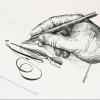
Original Crown Mill Vs Fritz-Schimpf
Andrew_L posted a topic in Paper & Pen Paraphernalia Reviews and Articles
https://images.vfl.ru/ii/1578313765/8a2faaad/29120766.jpg Montblanc Boheme (custom UEF\Needlepoint), Montblanc Royal Blue, Fritz-Shimpf Feinpost, Fritz-Schimpf Leinen, Crown Mill Vellium, Crown Mill Classic Line|Verge https://images.vfl.ru/ii/1578315892/b0adffb7/29121062.jpg https://images.vfl.ru/ii/1578313768/a2e8c426/29120785.jpg More photo about paper test. (Sorry, post in Cyrillic but with many informative photos. If you need translate to English I can do it in a few days).- 5 replies
-
- original crown mill
- fritz-schimpf
- (and 8 more)





